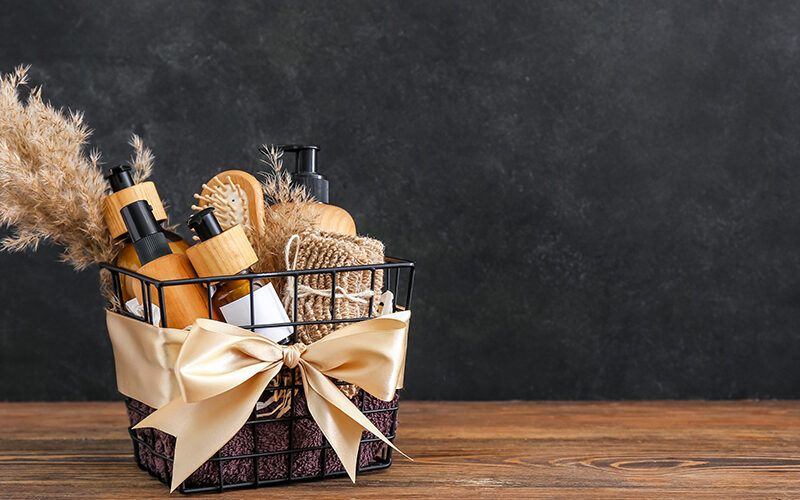Gift baskets are a wonderful way to showcase your product—especially around the holidays, in markets, and at special events. They’re visually appealing, fun to assemble, and a great opportunity to pair complementary items together. But as soon as you package multiple items together and sell them as a single product, the labeling rules change.
Whether you’re offering spa baskets, seasonal gift sets, or curated assortments of soaps and skin care products, the moment those items become a pre-packaged set, the regulations say you’ve created one single retail package. And that package must meet the same labeling requirements as any other cosmetic or soap product that you sell.
The good news is that the rules are straightforward, once you understand them. Let’s walk through what’s required, why it matters, and how you can implement it smoothly in your workflow.
When a Gift Basket Becomes a “Single Package”
The key distinction is whether the gift basket is packaged prior to being offered for sale.
If you assemble the basket in advance, tie the bow, shrink-wrap the contents, add crinkle paper, and set it out with a price tag, the entire basket is considered one package in the eyes of the regulations. That means:
- Shoppers must be able to see all required information before buying it.
- The basket needs its own labeling on the outside—not buried inside.
- The label can be on a hang tag, a sticker, a card attached to the handle, or any format that’s easy to see when the customer looks at the package.
This is true regardless of whether the products inside are individually labeled. Each individual item may still be properly labeled, but the basket as a whole also needs its own exterior label.
If, on the other hand, a customer buys products individually and then asks you to wrap or package them as a gift, you are essentially providing a gift-wrapping service. In that case, the gift set does not need its own outer label, because the labeling requirement for purchase-decision information has already been satisfied. The products were purchased as individual items with complete labels, and the wrapping is simply decorative.
But when you package the items first and sell the set, the gift basket rules apply—so let’s look at what you must include.
Net Contents for Gift Baskets: List Everything Clearly
For the purpose of net content statements, a pre-packaged gift basket is considered a combination pack because it includes multiple different products.
That means the net contents must:
- List each distinct item in the basket separately
- Include the quantity of each item
- Include the net weight or volume for each cosmetic product
- Use appropriate units of measure—fluid measure for liquids; weight for solids
- Combine similar items when appropriate
- Remember that the required text size is based on the principal display panel of the gift basket so it may be 3/16 or 1/4 of an inch (much bigger than the required size on an individual package).
Here’s a simple example of how that might look:
1 lotion – 8 fl oz (236 ml)
1 shampoo – 8 fl oz (236 ml)
2 soaps – 4 oz (113 g) each
1 hand cream – 2 oz (56 g)
1 washcloth – 12" x 12"A few practical notes:
- For soaps, list the lowest net weight it’s likely to be (after any additional evaporation) when the customer buys it.
- Non-cosmetic items, such as washcloths or accessories, can be listed by size and count.
- You don’t need to add together the weights of unlike items—just list each separately so the consumer knows exactly what’s inside.
Think of the net contents as a clear, concise inventory that helps the buyer understand what they’re purchasing.
Ingredient Declarations: One Gift Basket, Multiple Products
Ingredient labeling for gift baskets is one of the areas where makers tend to feel confused, but it’s actually fairly straightforward once you separate the pieces.
When a gift basket contains cosmetics, the outside of the basket must include:
- A complete ingredient declaration for each cosmetic item inside the package
- Ingredients for each product listed in the correct order (the same as on the individual package)
You can arrange them clearly using product names or product types. You don’t need to recreate each label exactly as printed on the product—just use the correct ingredient declaration for each item. For example:
Lotion Ingredients: Water, Aloe Barbadensis Leaf Juice, …
Soap Ingredients: Olive Oil, Coconut Oil, Sodium Hydroxide, …
Hand Cream Ingredients: Water, Glycerin, …Business Name and Address: Required on the Outside
As with any cosmetic product, the responsible person’s business name and address must be included on the outside of the gift basket.
If your business name and address already appear on each product label inside the basket, that’s great (and as it should be)—but the gift basket itself also needs the information. The whole package is a product for sale and must meet the standard requirements.
All the rules about the Business Name and Address on the product apply to their inclusion on a Gift Basket label.
Where and How to Place the Label
You have some flexibility, as long as the information is visible before purchase. As with all products, the net contents must be on the front (principal display panel). Common options include:
- A hang tag tied to the basket
- A sticker or card attached to the shrink wrap
- A panel printed on a box if the basket or set is boxed rather than wrapped
Just remember that the label should:
- Be easy to find (net weight on the front)
- Be clear and readable
- Include all required information in one place
Think of how the customer will see the basket: if they can pick it up and immediately find the required labeling, you’re in good shape.
When a Gift Basket Doesn’t Require an External Label
If you offer a gift basket service—meaning a customer purchases already-labeled products from you and then asks you to package them together as a gift—no additional labeling is required.
Why? Because:
- The labeling requirement is primarily to support the consumer’s purchasing decision.
- The customer already saw the labels and chose the products.
- You’re providing a wrapping service, not creating a new product.
This is similar to gift-wrapping at a department store. The store doesn’t relabel the wrapped package because the customer already bought the item inside based on its original label.
Practical Tips for Streamlining Gift Basket Compliance
- Create a template. Make a standard basket label layout you can reuse for multiple sets.
- Save ingredient lists separately. That way, you can quickly copy/paste the accurate declarations for each product.
- Offer limited variations. Fewer basket styles make labeling faster and less error-prone.
- Keep sample labels handy. This helps ensure you’re using exactly the same ingredient list as the individual product.
- Proofread carefully. Gift baskets often involve multiple products—typos can multiply quickly.
If you are wrapping at the time of purchase as a gift-wrap service, keep your wrapping as simple as possible so you can do it quickly for the customer.
Final Thoughts
Gift baskets are a great way to boost sales, especially during busy seasons. With a little preparation, you can keep the process smooth, compliant, and stress-free.
The key is to remember that a gift basket sold as a unit needs to be labeled as a unit. Provide clear net contents, accurate ingredient declarations, and your business information, all in one place where the customer can see it.
Once you have your system in place, labeling gift baskets becomes routine—a simple checklist item rather than a headache.
If you have questions about labeling or want help reviewing your gift basket labels (or any other compliance challenges), I’m always here to help.


Leave a Reply